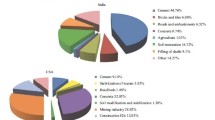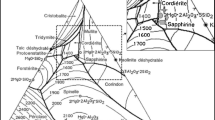Abstract
In the United States, approximately 50 million tonnes of fly ash are generated by electrical utilities annually. The current consumption rate for fly ash materials is less than 20% because most fly ash materials do not meet market specifications and the quality of the ash is inconsistent. A beneficiation process that produces quality-controlled fly ash components has been developed. The synthesis of mullite as a refractory material is one industrial application for the silicate sphere component from the beneficiated fly ash. As-received (untreated) fly ash did not produce a usable mullite refractory. This article discusses the fly ash beneficiation process and mullite synthesis.
Similar content being viewed by others
References
R.E. Balzhiser and K.E. Yeager, “Coal-fired Power Plants for the Future,” Scientific American, 257(3) (September 1987), p. 100.
“1991 Coal Combustion By-Products—Production and Consumption,” compiled by the American Coal Ash Association, 1992.
V.R. Sturrup, “A Review of the Use of Ontario Hydro Fly Ash in Concrete” Proceedings: Research and Development Needs for Use of Fly Ash in Cement and Concrete, EPRI Report CS-2616-SR (Palo Alto, CA: Electric Power Research Institute, 1982), pp. 3–12.
G.J. Jablonski and S.S. Tyron, “Overview of Coal Combustion By-Product Utilization,” Proceedings of the Fifth International Pittsburgh Coal Conference (Pittsburgh, PA: University of Pittsburgh, 1988), p. 15.
Claire L. Carlson and Domy C. Adriano, “Environmental Impacts of Coal Combustion Residues,” J. Environ. Qual., 22 (April–June 1993), pp. 227–247.
“Final Report—Fly Ash Processing and Utilization,” Institute of Materials Processing at Michigan Technological University, Project No. MDRD-1-31-20025,1994.
J.Y. Hwang et al., “Application of Characterization on Fly Ash Beneficiation to Produce Quality Controlled Products,” Process Mineralogy Xl-Characterization of Metallurgical and Recyclable Products, ed. D.M. Hausen et al. (Warrendale, PA: TMS, 1991).
“Classification of Fly Ash for Use in Cement and Concrete,” EPRI Report CS-5116, Baker/TSA, Inc. (April 1987).
A.J.C. Watts, “Full-Scale Experiments on the Addition of Pulverized Fuel Ash in Brickmaking,” Trans. British Ceramic Society, 53 (1954), p. 314.
O.E. Manz, “Utilization of Lignite and Subbituminous Combustion Ashes, Slags and Scrubber Sludges and Gasification Ashes in a Variety of Commercially Viable Products,” Proceedings: Eighth International Ash Utilization Symposium, vol. 2, EPRI Report CS-5362 (Palo Alto, CA: Electric Power Research Institute, October 1987), Ch. 60.
R.W. Styron, “Fly Ash Lightweight Aggregate: The Afflite Process,” Proceedings: Eighth International Ash Utilization Symposium, vol. 2, EPRI Report CS-5362 (Palo Alto, CA: Electric Power Research Institute, October 1987), Ch. 58.
G. Burnet and A.J. Gokhale, “Experimental Studies of the Production of Lightweight Aggregate from Flyash/Coal Cleaning Refuse Mixtures,” Proceedings: Eighth International Ash Utilization Symposium, vol. 2, EPRI Report CS-5362 (Palo Alto, CA: Electric Power Research Institute, October 1987), Ch. 61.
D. Hunsucker et al., “Road Base Construction Utilizing Coal Waste Materials,” Proceedings: Eighth International Ash Utilization Symposium, vol. 1, EPRI CS-5362 (Palo Alto, CA: Electric Power Research Institute, October 1987), Ch. 22.
W.F. Boles, “Fly Ash Facts for Highway Engineers,” FHWA-D9-59-8 ((Washington, D.C.: Federal Highway Admin., 1986).
A.M. Digioia, Jr. and D.M. Golden, “High-Volume Ash Utilization in Roadways, Embankments and Backfills—An Update,” EPRI Report CS-5362 (1986), pp. 50–51.
“Evaluation of Plastic Filler Applications for Leached Fly Ash,” EPRI Report CS-4765, Ontario Research Foundation (Palo Alto, CA: Electric Power Research Institute, September 1986).
Coal Combustion By-Products Utilization Manual, vol. 1: Evaluating the Utilization Option, EPRI Report CS-3122 (Palo Alto, CA: Electric Power Research Institute, February 1984).
D.M. Golden, “EPRI Coal Combustion By-Product Utilization R&D,“ Proceedings of the Fifth Annual International Pittsburgh Coal Conference (Pittsburgh, PA: University of Pittsburgh, 1988), p. 32.
Recovery of Metal Oxides from Fly Ash Including Ash Beneficiation Products, Vol. 1: Product Market Survey Report, EPRI Report CS-4384 (Palo Alto, CA: Electric Power Research Institute, February 1986).
“Fly Ash and Raw or Calcined Natural Pozzolan for use as a Mineral Admixture in Portland Cement Concrete,” Standard C618-89a (Philadelphia, PA: ASTM, 1989)
Engineered Materials Handbook, Vol. 4: Ceramics and Glasses (Materials Park, OH: ASM, 1991).
Jiann-Yang Hwang, “Wet Process for Fly Ash Beneficiation,” U.S. patent 5,047,145 (September 10, 1991) and U.S. patent 5,227,047 (1993).
“Modern Refractory Practice,” (Pittsburgh, PA: Harbison-Walker Refractories Company, 1961).
“A Synthetic Mullite Refractory for Aggressive Furnace Conditions,” Am. Cer. Soc. Bulletin, 72 (7) (July 1993), pp. 40-42.
P.D.D. Rodrigo and P. Boch, “High Purity Mullite Ceramics by Reaction Sintering,” Int. J. High Tech. Cer., 1(1985), pp. 3–30.
S. Hori, R. Kurita, and Y. Hirata, “Fabrication of Mullite Ceramics from CVD Al2O3-SiO2 Powders,” pp. 259–60(3-1 C10) in Extended Abstracts of 1st Autumn Symposium (Tokyo: The Ceramic Society of Japan, 1988).
M.G.M.U. Ismail, Z. Nakai, and S. Somiya, “Microstructure and Mechanical Properties of Mullite Prepared by the Sol-Gel Method,” J. Am. Ceram. Soc., 70(1) (1987), pp. C–7-C-8.
Takeshi Ohtake et al., “Synthesis of Mullite from Fly Ash and Alumina Powder Mixture,” J. Ceramic Society of Japan, International Edition, 99(N3) (March 1991), pp. 55–59. This work was funded by a grant (MDRD-1-31-20025) from the Michigan Department of Natural Resources under the “Solid Waste Alternatives Program” (SWAP) of the “Protecting Michigan’s Future” bond.
Author information
Authors and Affiliations
Rights and permissions
About this article
Cite this article
Hwang, JY., Huang, X. & Hein, A.M. Synthesizing mullite from beneficiated fly ash. JOM 46, 36–39 (1994). https://doi.org/10.1007/BF03220694
Issue Date:
DOI: https://doi.org/10.1007/BF03220694




